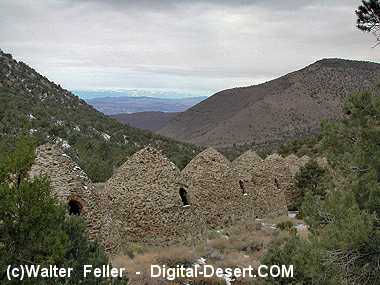Wildrose Charcoal Kilns
In 1877 George Hearstís Modock Consolidated Mining Company completed construction of the charcoal kilns in
Wildrose Canyon. The charcoal produced by the kilns was to be used as fuel for two silver-lead smelters that
Hearst had built in the Argus Range 25 miles to the west. The kilns operated until the summer of 1878 when
the Argus mines, due to deteriorating ore quality, closed and the furnaces shut down.
The Wildrose kilns employed about 40 woodcutters and associated workmen, and the town of Wildrose, a temporary camp
located somewhere nearby, was home to about 100 people.
Remi Nadeauís
Cerro Gordo
Freighting Company hauled the
charcoal to the smelters by pack train and wagon.
Each of the 10 kilns stands about 25 feet tall and has a circumference of approximately 30 feet. Each kiln
held 4 cords of pinyon pine logs and would, after burning for a week, produce 2,000 bushels of charcoal.
Considered to be the best surviving examples of such kilns to be found in the western states, the kilns owe
their longevity to fine workmanship and to the fact that they were in use for such a short time.
The Wildrose Charcoal kilns are located in Wildrose Canyon on the western side of Death Valley National Park.
Access the Wildrose Canyon road from California Highway 178 between Trona and Panamint Springs. From California
Highway 190, take the Emigrant Canyon road south to the turnoff up the Wildrose Canyon road to the kilns.
The last 3 miles of the road are unpaved and the road is subject to storm closures.
Pictures of the Wildrose Charcoal Kilns
Pinyon Pine
Mature singleleaf pinyon is typically a short tree (20-40 feet (6-12 m) tall), with a rounded to flat-topped crown and multiple, upswept branches ...
Ecosystem notes:
The predominate ecology of this area is described in;
Panamint Range, the area also displays features of the Saline Valley - Cottonwood Mountains region, specifically, Pinyon-Juniper Woodland habitat.
For an overview of fauna see:
Ecological Sections: Southern Great Basin and Wildlife in Death Valley National Park.
Native Culture:
Most commonly described as the territory of the Koso Indians:
Also see; Death Valley Native Americans
